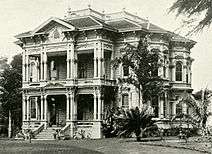Hermann A. Widemann
| Hermann A. Widemann | |
|---|---|
|
In the late1890s | |
| Born |
December 24, 1822 Hanover, Germany |
| Died |
February 7, 1899 (aged 76) Honolulu |
| Nationality | Kingdom of Hawaii |
| Occupation | Judge, Businessman, Politician |
| Children | 9 |


Hermann Adam Widemann (December 24, 1822 – February 7, 1899) was a businessman from Germany who was a judge and member of the cabinet of the Kingdom of Hawaii.
Life
Hermann Adam Widemann was born in Hanover, Germany on December 24, 1822.[1] As a teenager he went to work on a whaling ship. He came to live in the Hawaiian Islands in 1846, after stopping in 1843. He came briefly to the California Gold Rush in 1849, but returned after his companion John von Pfister was murdered.[2]:149 He married a native Hawaiian Kaumana "Mary" Kapoli in 1854 and lived in Līhuʻe.[3] He became sheriff of the island of Kauaʻi in 1854, was elected to the house of representatives in the legislature of the Hawaiian Kingdom in 1855, and in 1863 appointed its circuit judge.[4] He started one of the first sugarcane plantations in Hawaii known as Grove Farm. During the American Civil War he supported the Confederate States.[2]:180
After selling Grove Farm to its manager George Norton Wilcox,[5] in 1865 he moved to Honolulu to work in the capital. On July 10, 1869 he was appointed to the kingdom's supreme court, despite never having any formal law school training. On February 18, 1874 he was appointed to the cabinet as minister of the interior until May 28, 1874, as well as on the Privy Council, the board of education, commissioner of crown lands, president of the bureau of immigration, and board of health.[4] In 1878 he started the Waianae Sugar Company in the Waiʻanae district of Oʻahu island.[6]
On February 25, 1891 he was appointed as Minister of Finance to Queen Liliʻuokalani, but had to resign two weeks later on March 10. He was temporarily replaced by Samuel Parker, and then John Mott-Smith. After Mott-Smith was sent to Washington, DC to attempt to negotiate a trade treaty, Parker served again briefly until Widemann resumed his duties as minister of finance. He also filled in briefly as Attorney General from July 27, 1892 to August 29, 1892.[4] After the 1893 overthrow of the Kingdom of Hawaii, Widemann was sent with Parker and John Adams Cummins to Washington, DC, in an attempt to get international support for its restoration He then continued to London, and Berlin but was never successful.[1]
Widemann was interviewed by US Commissioner James H. Blount in preparing his Blount Report on May 20, 1893.[7] He was the first to experiment with the Guatemalan variety of coffea tree, which turned out to be well-adapted to higher elevations; it became the most popular variety through modern times.[8]
He died February 7, 1899.[9][10] After a funeral in the Cathedral of Our Lady of Peace, he was buried in Oahu Cemetery. He was survived by two sons and seven daughters.[1]
His son Carl Widemann married Helen Umiokalani Parker, daughter of Samuel Parker in July 1899.[11][12] A street is named for him in Mākaha at 21°28′15″N 158°13′1″W / 21.47083°N 158.21694°W.
See also
| Wikimedia Commons has media related to Hermann A. Widemann. |
References
- 1 2 3 "Hawaiians Mourn: Herman A. Widemann Dies After a Prolonged Sickness". The Independent. Honolulu. February 7, 1899. p. 3. Retrieved June 24, 2010.
- 1 2 Edward Joesting (1988). Kauai: The Separate Kingdom. University of Hawaii Press. ISBN 978-0-8248-1162-4.
- ↑ "Marriage Record Book for island of Kauai" (PDF). Retrieved June 23, 2010.
- 1 2 3 "Widemann, Hermann A. office record". state archives digital collections. state of Hawaii. Retrieved June 23, 2010.
- ↑ "History". Grove Farm web site. Retrieved June 23, 2010.
- ↑ "Cultural History of Wai'anae". State of Hawaii. Retrieved June 24, 2010.
- ↑ "Blount Report: Affairs in Hawaii". pp. 1001–1004. Retrieved June 23, 2010.
- ↑ Baron Goto (1982). "Ethnic Groups and the Coffee Industry in Hawaii". 16. Hawaiian Historical Society. pp. 112–124.
- ↑ "Part 2 Glossary (T-Z)". Hawaiian Encyclopedia. Retrieved June 23, 2010.
- ↑ "H. A. Widemann: Resolutions of Respect in Supreme Court: Feeling Eulogies Spoken". Hawaiian Gazette. March 21, 1899. p. 1. Retrieved June 23, 2010.
- ↑ Kapiikauinamoku (May 23, 1956). "Second Son of Parkers, Palmer, Died As Youth". The Story of Maui Royalty: The Parkers of Waimea.
- ↑ "A Beautiful Wedding". The Independent. Honolulu. July 21, 1899. p. 4. Retrieved June 23, 2010.
| Government offices | ||
|---|---|---|
| Preceded by E. O. Hall |
Kingdom of Hawaii Minister of Interior February 1874 – May 1874 |
Succeeded by W. L. Green |
| Preceded by Godfrey Brown |
Kingdom of Hawaii Minister of Finance February 1891 – March 1891 |
Succeeded by Samuel Parker |
| Preceded by Samuel Parker |
Kingdom of Hawaii Minister of Finance January 1892 – September 1892 |
Succeeded by E. C. MacFarlane |
| Preceded by William A. Whiting |
Kingdom of Hawaii Attorney General July 1892 – August 1892 |
Succeeded by Paul Neumann |

